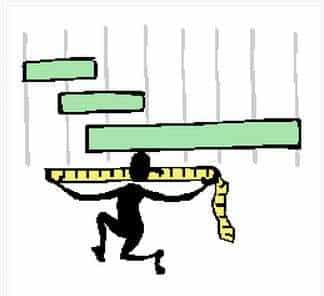Is Depreciation a Direct Cost or Indirect Cost?

Depreciation is key for cost accounting; however, it can be tricky to determine if it is a direct or indirect cost. Direct costs are usually tied to creating goods or services; thus, one would think depreciation (which is about the wear & tear of resources used in production) would fall into this category. Nevertheless, it is usually considered an indirect cost since it is spread out over multiple departments. Is depreciation a direct cost or indirect cost?
Definition of Depreciation
Depreciation is a decrease in the value of an asset due to wear or obsolescence. It is a key concept in accounting, as it helps businesses distribute the cost of an asset over its life. Depreciation is both a direct and indirect cost.
Directly, it is part of the cost of goods sold for manufacturers or cost of services for service providers. It decreases the contribution margin of a product or service. It can also be an indirect cost, allocated to various departments or functions, not related to the production of a product or service.
It is important to note that depreciation does not involve actual cash outflows. It reflects the gradual consumption or loss of value of an asset over time. Whether depreciation should be treated as a direct or indirect cost depends on how it is allocated and attributed within financial records.
Introduction to Direct and Indirect Costs
It may seem strange to categorize depreciation as indirect, but there are logical reasons. Firstly, unlike direct costs, which can be allocated to specific products/services, depreciation cannot. Instead, it is spread out over time and recorded on the organization’s income statement. This way, it can be allocated in a way that reflects its use by different departments.
The second reason is that depreciation impacts the entire organization and not just certain parts. It affects profitability and cash flow, and thus influences investment decisions and overall financial performance. By classifying it as an indirect cost, all of these factors are taken into account.
To manage depreciation well as an indirect cost, companies should consider a few steps. Firstly, they need a reliable method for calculating asset lifespan and value reduction. This ensures accurate allocation of depreciation expenses and avoids misrepresentation of costs.
Secondly, businesses should regularly review their fixed asset register. This checks that assets are correctly classified and reflect their current state accurately. Doing so minimizes mistakes in reporting and enhances decision-making across the organization.
Explanation of Direct Costs
Direct costs are expenses that can be linked to a specific cost object, such as a product, service or project. These costs directly affect the production or purchase of goods or services. They are part of the main activities of a company and are important for calculating the overall cost of production.
Let’s look at some examples:
| Cost Category | Description |
|---|---|
| Direct Materials | These are materials that can be related to the final product. For example, in the manufacturing industry, raw materials like wood, steel or plastic are direct materials. |
| Direct Labor | This includes wages and salaries paid to employees who work directly on the production process. Their actions can be linked to certain products or services. |
| Direct Expenses | Certain expenses are connected to a certain cost object. For example, if an advertising campaign is just for promoting one product, the advertising expenses become part of its direct costs. |
It’s important to understand these direct costs, as they can help businesses make accurate pricing decisions and assess profitability. By analyzing these costs separately from indirect costs, companies can get a better idea of the true cost of their products or services.
It is interesting to note that the concept of identifying and classifying direct costs has been around for centuries. Historical records show that the Egyptians tracked direct material and labor costs during the construction of pyramids, through detailed hieroglyphics.
Explanation of Indirect Costs
Indirect costs are expenses that cannot be linked to any single product or service. They are related to the overhead of a business, like rent, utilities, insurance, and staff salaries. Direct costs can be attributed to a product or service, but indirect costs are more difficult to allocate. They’re shared between multiple activities or departments.
Indirect costs can be split into fixed and variable. Fixed costs don’t change with production or sales – like office rent. Variable costs, however, go up or down with the level of activity – like electricity used in a manufacturing facility.
Comprehending and managing indirect costs is essential for businesses. It helps uncover the real cost of producing a good or service. By allocating these costs accurately, companies can make informed decisions about pricing and resources. Monitoring indirect costs also shows businesses where improvements in efficiency can be made.
Determining the Classification of Depreciation
Figuring out depreciation classifications can be tough. We must figure out if it is a direct or indirect cost, in order to distribute expenses correctly. Here is a breakdown of the factors used:
| Factor | Direct Cost | Indirect Cost |
| Direct Relationship | Depreciation directly involved with one product or service. | Depreciation linked with multiple products or services. |
| Traceability | Depreciation easy to trace back to specific products or services. | Depreciation tough to trace back to individual products or services. |
| Allocation Method | Depreciation using a certain formula for each product or service. | Depreciation using a general formula for all products or services. |
It is essential to classify depreciation accurately. This helps us to allocate costs and understand their influence on individual products or services. Neglecting to do so may cause erroneous financial info and bad decisions.
Case Studies and Examples
Depreciation is a key part of financial accounting. It can be either a direct or indirect cost of products. To understand this better, let’s look at some examples.
The table below shows different scenarios:
| Scenario | Depreciation Cost |
|---|---|
| Company A | Direct |
| Company B | Indirect |
| Company C | Direct |
Company A produces machinery. Therefore, depreciation is a direct cost associated with the production process. Company B, however, offers marketing services. As such, depreciation is seen as an indirect cost as it cannot be easily linked to specific products or services.
Other factors can affect how depreciation is classified, such as industry type, business goals and internal accounting rules.
Here’s a real-life example:
A manufacturing company from Ohio had trouble allocating depreciation costs across their production lines. After in-depth research and analyzing their financial statements, they used activity-based costing (ABC). This let them identify which parts of depreciation were direct costs for each product line, and improve their cost management strategies.
These cases and examples give us an idea of the complexity of depreciation allocation. They also help businesses manage it more effectively.
Depreciation a Direct Cost or an Indirect Cost?
Depreciation: a direct cost or an indirect cost? Let us consider the facts.
- Depreciation is an indirect cost, as it doesn’t directly affect production.
- It’s a non-cash expense, representing the decrease in asset value over time.
- It affects profitability but isn’t linked to production or specific products.
- Indirect costs like depreciation are usually allocated across products or activities, according to predetermined methods.
So, it’s clear that depreciation is an indirect cost. Its impact on production may be small, but it’s important when calculating the cost of assets over their useful life.
Here’s a pro tip: Properly categorizing direct and indirect costs is necessary for effective decision-making.
Frequently Asked Questions
FAQ 1:
Question: Is depreciation considered a direct cost or indirect cost?
Answer: Depreciation is generally considered an indirect cost. It is an expense that is not directly tied to the production of a specific product or service.
FAQ 2:
Question: Why is depreciation considered an indirect cost?
Answer: Depreciation is allocated to different cost centers or departments based on the usage of assets. Since it cannot be directly traced to a specific product or service, it is classified as an indirect cost.
FAQ 3:
Question: Can depreciation ever be considered a direct cost?
Answer: In some cases, if the depreciation expense is directly tied to the production of a specific product or service, it may be classified as a direct cost. However, this is relatively uncommon.
FAQ 4:
Question: How is depreciation treated in financial statements?
Answer: Depreciation is recorded as an expense in the income statement and also reduces the value of the asset on the balance sheet over its useful life.
FAQ 5:
Question: Is there a difference between depreciation and other indirect costs?
Answer: Yes, depreciation is a specific type of indirect cost that represents the wear and tear or loss in value of tangible assets over time. Other indirect costs may include expenses like rent, utilities, or salaries.
FAQ 6:
Question: How can businesses calculate depreciation?
Answer: Businesses can calculate depreciation using methods such as straight-line depreciation, accelerated depreciation, or units-of-production depreciation. These methods allocate the cost of the asset over its useful life.
















Leave a Reply